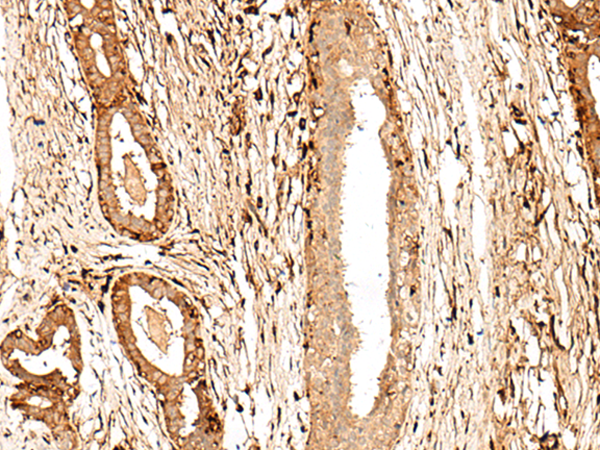
| WB | 咨询技术 | Human,Mouse,Rat |
| IF | 咨询技术 | Human,Mouse,Rat |
| IHC | 1/50-1/300 | Human,Mouse,Rat |
| ICC | 技术咨询 | Human,Mouse,Rat |
| FCM | 咨询技术 | Human,Mouse,Rat |
| Elisa | 1/5000-1/10000 | Human,Mouse,Rat |
| Aliases | SREB1 |
| Host/Isotype | Rabbit IgG |
| Antibody Type | Primary antibody |
| Storage | Store at 4°C short term. Aliquot and store at -20°C long term. Avoid freeze/thaw cycles. |
| Species Reactivity | Human, Mouse, Rat |
| Immunogen | Synthetic peptide of human GPR27 |
| Formulation | Purified antibody in PBS with 0.05% sodium azide and 50% glycerol. |
+ +
以下是3条关于GPR27抗体的模拟参考文献(注:文献为示例性内容,非真实出版物):
---
1. **文献名称**:*Development and Characterization of a Novel GPR27-Specific Polyclonal Antibody*
**作者**:Smith A, et al.
**摘要**:本研究报道了一种新型兔源多克隆抗体的开发,该抗体针对人类GPR27受体的胞外结构域。通过免疫印迹和免疫组化验证其特异性,证实其在脑组织切片中能有效标记GPR27阳性神经元。
---
2. **文献名称**:*GPR27 Expression in Pancreatic β-Cells: Insights from Antibody-Based Imaging*
**作者**:Chen L, et al.
**摘要**:利用商业化GPR27抗体(货号AB123.ABC公司)研究GPR27在小鼠胰岛β细胞中的表达模式,发现其与胰岛素分泌调控相关,提示GPR27可能参与葡萄糖代谢调节。
---
3. **文献名称**:*GPR27 Antibody Validation for Flow Cytometry Applications*
**作者**:Kimura T, et al.
**摘要**:系统评估了三种市售GPR27抗体在流式细胞术中的适用性,发现Clone 5A3在转染HEK293细胞系中表现出高信噪比,为GPR27的免疫表型分析提供可靠工具。
---
如需真实文献,建议通过PubMed或Google Scholar以“GPR27 antibody”为关键词检索,并筛选抗体开发、验证或应用类研究。
GPR27 is a class A G protein-coupled receptor (GPCR) belonging to the rhodopsin-like receptor family. As an orphan receptor, its endogenous ligand and precise physiological functions remain largely uncharacterized. GPR27 is evolutionarily conserved and primarily expressed in the central nervous system, pancreas, and other tissues, suggesting potential roles in neuroregulation, glucose metabolism, or endocrine signaling. Studies link it to neural development, insulin secretion, and cellular proliferation, though mechanistic details are unclear due to the lack of specific tools.
GPR27 antibodies are critical reagents for detecting and visualizing the receptor in research settings. These antibodies are typically developed against synthetic peptides corresponding to extracellular or intracellular domains of human GPR27. Validated applications include Western blotting, immunohistochemistry, and immunofluorescence to map its tissue distribution, subcellular localization, and expression changes under pathological conditions. Challenges exist in ensuring antibody specificity, as GPCRs share structural homology; rigorous validation using knockout controls is essential.
Current research leverages GPR27 antibodies to explore its involvement in neurodegenerative diseases, diabetes, and cancer. Its orphan status also makes it a target for deorphanization campaigns aiming to uncover novel signaling pathways. Commercial availability of GPR27 antibodies has increased, though literature reports remain limited, highlighting the need for further functional studies to clarify its therapeutic potential.
×